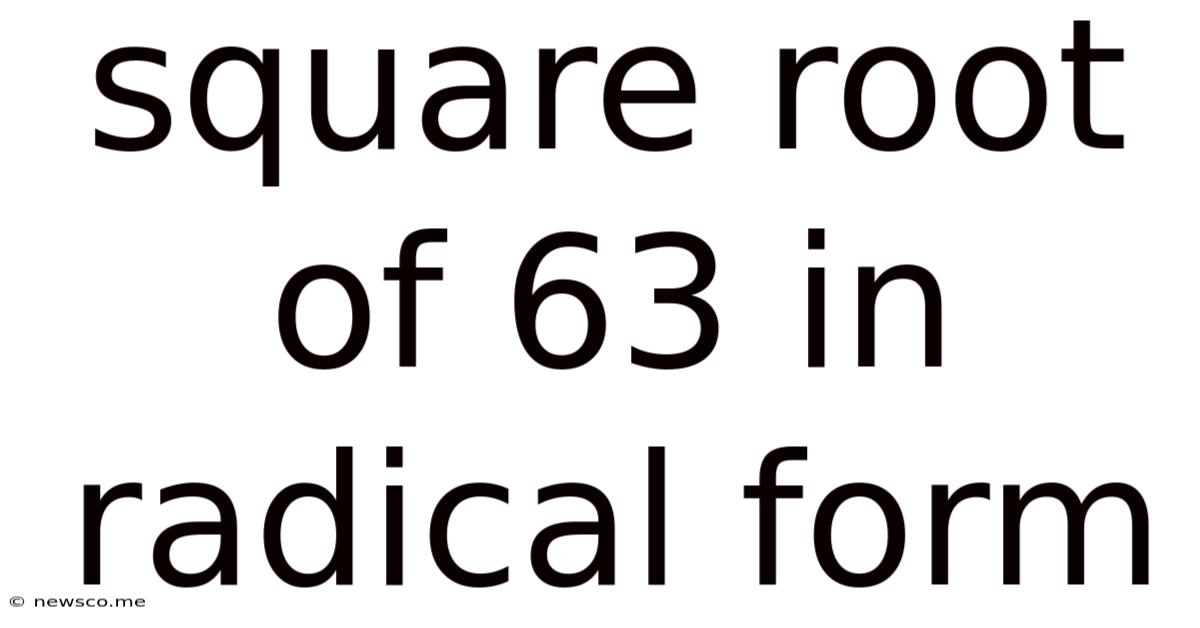Square Root Of 63 In Radical Form
News Co
Mar 20, 2025 · 4 min read

Table of Contents
Square Root of 63 in Radical Form: A Comprehensive Guide
The square root of 63, often represented as √63, might seem like a simple mathematical concept, but exploring it deeply reveals fascinating insights into number theory, simplifying radicals, and even the practical applications of these seemingly abstract ideas. This comprehensive guide delves into the intricacies of expressing √63 in its simplest radical form, touching upon fundamental concepts and exploring advanced techniques for similar problems.
Understanding Square Roots and Radicals
Before diving into the specifics of √63, let's establish a firm understanding of the core concepts. A square root of a number is a value that, when multiplied by itself, equals the original number. For example, the square root of 9 is 3 because 3 x 3 = 9. A radical is a mathematical symbol (√) representing the root of a number. The number under the radical sign is called the radicand.
In our case, the radicand is 63. We aim to express √63 in its simplest radical form, meaning we want to eliminate any perfect square factors from within the radical.
Prime Factorization: The Key to Simplification
The most effective method for simplifying radicals like √63 involves prime factorization. Prime factorization is the process of breaking down a number into its prime factors—numbers divisible only by 1 and themselves.
Let's find the prime factorization of 63:
- 63 is divisible by 3: 63 = 3 x 21
- 21 is also divisible by 3: 21 = 3 x 7
Therefore, the prime factorization of 63 is 3 x 3 x 7, or 3² x 7.
Simplifying √63
Now, we can use the prime factorization to simplify √63:
√63 = √(3² x 7)
Since the square root of a product is the product of the square roots, we can rewrite this as:
√63 = √(3²) x √7
The square root of 3² is simply 3, leaving us with:
√63 = 3√7
This is the simplest radical form of √63. We've extracted the perfect square factor (3²) from the radical, leaving the prime factor 7 within the radical.
Approximating the Value of 3√7
While 3√7 is the exact representation in radical form, it's often helpful to approximate its numerical value. We know that √7 is slightly less than 3 (since 2² = 4 and 3² = 9). Using a calculator, we find that √7 ≈ 2.646. Therefore:
3√7 ≈ 3 x 2.646 ≈ 7.938
This approximation allows for practical applications where a numerical value is needed.
Extending the Concept: Other Radicals
The method used to simplify √63 can be applied to other radicals. Consider the following examples:
-
√12: The prime factorization of 12 is 2² x 3. Therefore, √12 = √(2² x 3) = 2√3
-
√48: The prime factorization of 48 is 2⁴ x 3. Therefore, √48 = √(2⁴ x 3) = √(2²) x √(2²) x √3 = 4√3
-
√108: The prime factorization of 108 is 2² x 3³. Therefore, √108 = √(2² x 3² x 3) = 6√3
Notice the pattern: we aim to identify and extract perfect square factors from the radicand.
Advanced Techniques and Considerations
For larger numbers, the prime factorization process might become more involved. However, the fundamental principle remains the same: identify perfect square factors and extract them from the radical. For very large numbers, you can utilize advanced techniques such as the Euclidean algorithm to efficiently find the greatest common divisor and speed up the factorization process.
Practical Applications of Radical Simplification
While simplifying radicals may seem purely theoretical, it has numerous practical applications in various fields, including:
-
Geometry: Calculating lengths of sides and diagonals in geometric figures frequently involves square roots. Simplifying these radicals ensures cleaner, more manageable calculations.
-
Physics: Many physics equations involve radicals, particularly in mechanics and electromagnetism. Simplifying these radicals leads to more understandable and efficient problem-solving.
-
Engineering: Engineers often encounter radicals in structural calculations, determining optimal dimensions, and ensuring stability. Simplifying radicals here improves accuracy and efficiency.
-
Computer Graphics: In computer graphics and game development, calculating distances and positions frequently requires simplifying radical expressions for efficient rendering and animation.
Common Mistakes to Avoid
When simplifying radicals, several common mistakes should be avoided:
-
Incorrect Prime Factorization: Ensure accurate prime factorization of the radicand. A single error here will propagate through the simplification process, leading to an incorrect result.
-
Improper Extraction of Square Roots: Carefully identify and extract perfect square factors. Failure to extract all perfect squares will leave the radical in a non-simplified form.
-
Arithmetic Errors: Double-check your arithmetic at each step of the simplification process. A simple calculation error can invalidate the final result.
Conclusion: Mastering Radical Simplification
Simplifying radicals, as demonstrated with √63, is a fundamental skill in mathematics with broad practical implications. By mastering prime factorization and the techniques discussed here, you can confidently simplify complex radicals and effectively apply this knowledge across various disciplines. Remember to practice regularly, and you'll quickly develop proficiency in this essential mathematical skill. This understanding extends far beyond simply finding the square root of 63; it equips you with a powerful tool for tackling a wide range of mathematical problems and real-world applications. Understanding the underlying principles of prime factorization and radical simplification will strengthen your mathematical foundation and enhance your problem-solving capabilities in numerous contexts.
Latest Posts
Related Post
Thank you for visiting our website which covers about Square Root Of 63 In Radical Form . We hope the information provided has been useful to you. Feel free to contact us if you have any questions or need further assistance. See you next time and don't miss to bookmark.